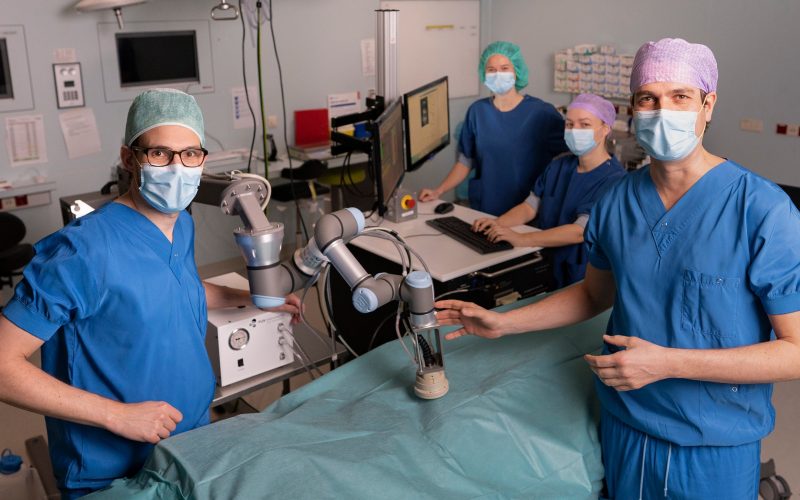Focusing high-frequency sound waves on a narrowing – a plaque – in the artery breaks it down layer by layer. That’s the theory behind High Intensity Focused Ultrasound (Hifu) treatment. “The first patients with artery stenosis in the groin have been treated with it,” says UMC Utrecht vascular surgeon Stijn Hazenberg. “And the results are encouraging.”
Narrowing of the arteries in the legs is called peripheral arterial disease, but it is also known as etalage legs. People who suffer from it, for example, find it much more difficult to walk. “In many places in the body, we treat vasoconstrictions by dotting, possibly in combination with placing a stent,” Stijn explains. “With constrictions in places like the groin, this does not work. This still requires invasive (open) surgery. We clamp off the arteries, open them up, remove the plaque and close them. Besides being invasive surgery, there is risk involved. Around 15 percent of people will get an infection after this. These infections vary in severity, but can have serious consequences up to and including amputation and even death.”
This is precisely why the new Hifu treatment is being tested precisely in patients with peripheral arterial disease. “This is where the most can be gained,” he says. In this treatment, an ultrasound head is used to image the plaque while at the same time sound waves are directed so that they meet in the plaque. The heat that causes this destroys the cell structures of the plaque, after which the physical mechanism occurs whereby white blood cells, among others, clean up the broken cells. Thus, point by point, the plaque is damaged and cleared by the body’s own immune system.
The Hifu treatment has been shown to be safe in an animal study, and now the first-in-human phase is underway. “Right now we are doing the safety study in a small group of patients,” Stijn says. “We first need to know for sure if the treatment is safe. In theory, this treatment with sound waves can cause clots to break loose. Incidentally, this can also happen with angioplasty. But we have to be sure that it doesn’t happen more often with the Hifu treatment, preferably not at all. The safety study is followed by an effectiveness study, with the aim of demonstrating scientifically that the treatment actually works. We have now treated five people in this way.”
78-year-old Anton Spel is one of those five. “I was getting more and more pain when walking. At one point I couldn’t go further than 400 meters. It turned out I had a blocked blood vessel in my groin. When the doctor asked me if I wanted to participate in research into a new treatment, I was fine with that. I didn’t notice anything from the treatment itself. Afterwards, I had to stay in the hospital for a few hours so they could check that everything was okay.”
Soon after the treatment, Anton noticed that walking improved. “With surgery, it would have taken much longer to recover. Besides, surgery is not without risk.” The pain is not yet completely gone. “I keep a little nagging pain, but walking is much better. Especially if I take it easy, I can walk a fair distance.”
Once Hifu treatment in the groin is finally scientifically proven to be effective, treatment of artery narrowing in other parts of the body is the next step. “In the upper or lower leg, for example,” says Stijn. “These cannot currently be overly bulky upper legs, because the maximum range of the sound waves is now about four centimeters. This is currently still a limitation of the current Hifu module. It could also be a potential treatment for arterial calcification in the neck. But we have to be extra careful with that, because if a clot breaks loose there, it will enter the brain directly with potentially serious damage. Incidentally, that also happens in two to three percent of patients with a classic carotid artery surgery or dotter.”
The Hifu technique comes from oncology. The UMC Utrecht is the first to use this technique for artery stenosis, still experimental for now. “We hope to complete this safety study within a year. The more extensive clinical study, which will follow, will take several years.”
Stijn calls innovations in the treatment of peripheral arterial disease desperately needed with the goal of making interventions even less invasive and more efficient. “There are many hospital and day hospitalizations in the Netherlands for patients with peripheral arterial disease (in 2019, 2998 and 1677 respectively) and it is expected that with the increase in the number of diabetics, this will increase further in the coming years.”
